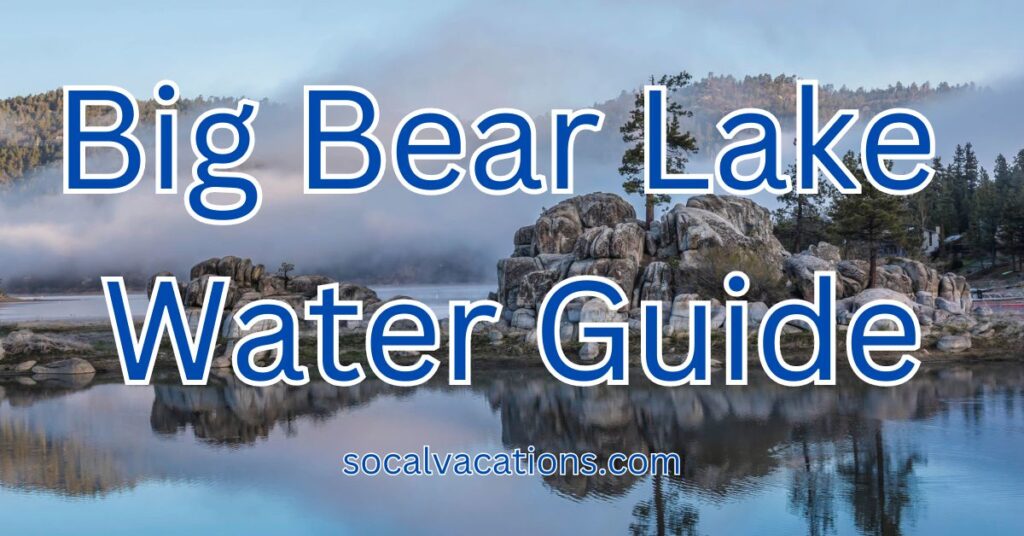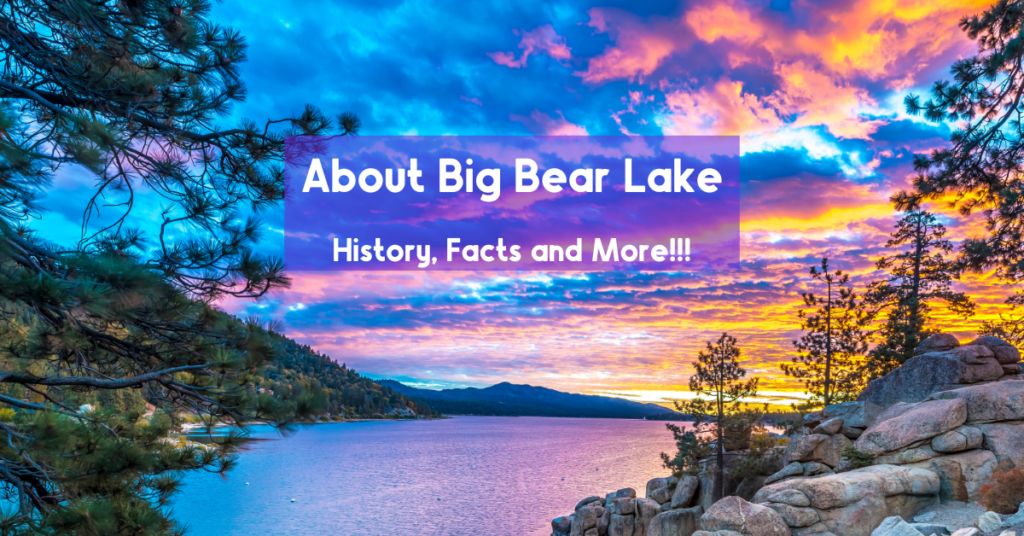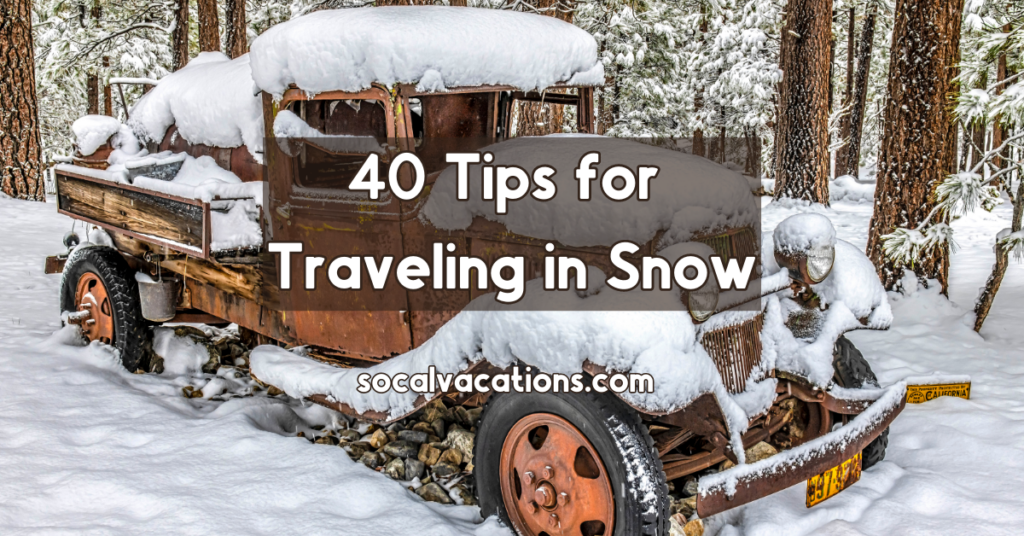Welcome to the Big Bear Lake Water Guide. This guide dives into the various water activities available in Big Bear Lake, while also providing valuable insights about the lake itself.
Big Bear Lake Water Activities
Big Bear Lake offers a variety of water activities including fishing and water sports. Its history and natural scenery enhance the experience. The lake is easy to access, has well-kept facilities, and prioritizes safety, accommodating families, solo travelers, and groups.
Boating and Sailing
Big Bear Lake is a fantastic place for those who love water activities, offering a broad spectrum of boating and watersports options. Whether you’re an experienced boater or someone new to watersports, there’s an activity to suit your interests.
Boating has been a significant part of the culture at Big Bear Lake. Visitors have a choice of boating experiences, and pontoons are particularly popular among those who seek a leisurely cruise on the lake.
Several marinas around the lake provide rentals, lessons, and guided tours for those keen on exploring the waters. Pontoons offer a stable and spacious platform, making them ideal for families, groups, or anyone looking to enjoy a relaxed day on the water.
The beautiful backdrop of the San Bernardino Mountains enhances the boating experience, making every voyage on the water a scenic adventure.
Marinas and boating clubs have sprung up over time, fostering a community of water enthusiasts. The increase in recreational boating activities has brought about various boating events and regattas, turning Big Bear Lake into a lively place for boating enthusiasts.
Aside from boating, the lake also offers a wide range of watersports, making it a destination for those seeking a bit of adrenaline. Jet skiing, water skiing, and wakeboarding are popular activities that offer a thrilling experience on the lake’s clear waters. For those interested in learning these watersports, there are facilities around the lake offering lessons to help you get started.
For a more relaxed pace, paddleboarding and kayaking are great choices. These activities offer a calm way to explore the lake, get some exercise, and enjoy the serene surroundings. They are also suitable for individuals of all ages and skill levels, making them a family-friendly option.
Wakeskating, a blend of wakeboarding and skateboarding, provides a unique challenge on the water for enthusiasts looking to try a new adventure.
With a variety of boating and watersports activities available, Big Bear Lake caters to different interests and skill levels. The thrill of jet skiing, the tranquility of paddleboarding, and the challenge of wakeskating are just a glimpse of what the lake offers. Alongside the picturesque scenery of the San Bernardino Mountains, every water adventure at Big Bear Lake promises a memorable experience.
Here are a couple of places you’ll want to check out.
Specializing in boat rentals, jet ski rentals, wakeboarding, and wakeskating, Designated Wakesports offers thrilling water sports experiences.
Offering pontoon boats, fishing boats, and kayaks, Big Bear Marina provides rentals for all skill levels.
Known for its luxury pontoon boats and guided lake tours, Pine Knot Marina offers a premium boating experience.
Fishing in Big Bear Lake
Big Bear Lake is a haven for fishing enthusiasts. It hosts an array of fish species including rainbow trout, smallmouth and largemouth bass, blue catfish, panfish, black crappie and unfortunately, invasive carp (though you can bow hunt carp).
The lake’s fishing spots have a reputation among anglers, and fishing tournaments are organized throughout the season, adding a competitive zest to the tranquil waters.
Fishing is deeply rooted in Big Bear Lake’s history, dating back to around 1884 when the first dam was thought of and completed in 1885. Fishing as a recreational activity surged after the construction of a larger dam in 1912, which increased the lake’s capacity significantly.
The dam’s construction led to more water being retained in the lake, which in turn supported a thriving fish population. By the early 20th century, the introduction of trout transformed Big Bear Lake into a sought-after fishing destination, paving the way for the establishment of fishing tournaments and guided fishing tours, which bolstered the local tourism industry significantly.
The sustainability of fishing activities is a priority for the lake’s management. The Big Bear Municipal Water District has taken a significant step in this direction by initiating the construction of a $3.5 million hatchery facility.
This new facility, poised to be among the largest in the state and constructed on a 1.25-acre district-owned property, aims to produce approximately 160,000 pounds of Rainbow Trout annually. While about 150,000 pounds of fish per year are designated for stocking Big Bear Lake to significantly bolster its fishing ecosystem, the excess fish are planned to be sold to nearby lakes like Santa Anna River Lakes and Lake Arrowhead, aiding in offsetting the operational costs.
Besides enriching the local aquatic ecosystem, this hatchery is poised to serve as an educational center with a budget of $250,000 allocated annually to educate the public about fish life cycles and other ecological essentials critical to the Big Bear Valley ecosystem.
The fish hatchery is a testament to Big Bear Lake’s commitment to sustainable fishing practices, ensuring a thriving aquatic ecosystem for present and future generations of anglers. This commitment not only provides a rewarding and responsible fishing experience but also preserves the lake’s rich fishing tradition, which has evolved and flourished over centuries, from the times of the Serrano people to the modern-day fishing enthusiast.
Continuing from the historical and sustainable fishing practices, Big Bear Lake has grown to be more than just a fishing destination. It’s a community hub where fishing is celebrated, whether through casual weekend fishing trips or through competitive tournaments held throughout the year. The local marinas and bait shops serve as gathering spots for anglers to share stories, learn from each other, and prepare for their next fishing adventure.
The ongoing fishing tournaments serve not only as competitions but also as events that bring together the community and visitors, showcasing the lake’s bounty and fishing culture. These tournaments often have categories for different fish species and age groups, making them inclusive and exciting for everyone involved.
The introduction of trout in the early 20th century was a game-changer for Big Bear Lake. The lake’s reputation as a prime spot for trout fishing drew enthusiasts from near and far, thereby fostering a vibrant fishing culture that continues to thrive today.
The lake’s tourism industry has embraced this culture, with many businesses offering guided fishing tours, boat rentals, and fishing gear rentals. This makes it easy for anyone, regardless of their level of experience, to partake in fishing activities and enjoy the lake’s offerings.
The educational aspect brought forth by the new hatchery, in terms of informing and educating the public about the life cycles of fish and the ecological needs essential to the Big Bear Valley ecosystem, plays a vital role in creating an informed community. It also attracts visitors keen on learning about aquatic life, further contributing to the lake’s status as a hub for recreational and educational experiences1.
The sustained growth of recreational boating and fishing has, over the years, led to the establishment of various boating and fishing clubs. These clubs often organize events, workshops, and community outreach programs, promoting not only the sport but also the importance of preserving the natural habitat that makes Big Bear Lake a unique place for fishing.
The history, sustainable practices, and community engagement around fishing in Big Bear Lake have woven a rich tapestry of experiences that resonate through the generations. The lake’s allure continues to beckon anglers and nature enthusiasts, promising a blend of adventure, learning, and community camaraderie that is rare to find elsewhere.
Here are a couple of fishing charters.
Offering guided fishing tours, Cantrell Guide Service provides expert guidance for anglers of all levels.
Specializing in family-friendly fishing trips, Lucky Bear Fishing Charters ensures an enjoyable fishing experience.
Paddleboarding and Kayaking
Paddleboarding and kayaking are popular activities on Big Bear Lake, offering a peaceful way to explore the lake’s hidden coves and shoreline. They have become increasingly popular in Big Bear Lake over the past few decades. The lake’s clear waters and scenic surroundings provide an ideal setting for these activities.
Local businesses and rental shops have made paddleboarding and kayaking accessible to all, contributing to their growth as favorite pastimes on the lake.
The development of designated paddleboarding and kayaking areas ensures a safe and enjoyable experience. Community events, such as races and festivals, celebrate these activities, creating a vibrant and inclusive paddleboarding and kayaking culture in Big Bear Lake.
Here are a couple of places to rent paddleboards.
An annual event celebrating paddle sports, Big Bear PaddleFest offers races, demos, and clinics.
Offering paddleboard and kayak rentals, Captain John’s Marina provides everything needed for a day on the water.
Swimming in Big Bear Lake
Swimming in Big Bear Lake can be dangerous due to underwater vegetation. The lake’s rapid filling has left hazardous underwater vegetation, making swimming risky. Water sports are encouraged, but swimmers should exercise caution.
Cold Water Considerations and Safety in Big Bear Lake
Big Bear Lake’s water temperature varies throughout the year. The lake is open for water activities during the summer season, typically from May to October. It is prohibited to enter the lake during the off-lake season, as the water temperatures can drop significantly, increasing the risk of hypothermia.
Average Water Temperature in Big Bear Lake by Month
The following table shows the average water temperature in Big Bear Lake by month. Data sourced from here.
| Month | Temperature (°F) |
|---|---|
| January | 59.72F (15.4C) |
| February | 59.52F (15.29C) |
| March | 59.94F (15.52C) |
| April | 61.32F (16.29C) |
| May | 63.79F (17.66C) |
| June | 66.34F (19.08C) |
| July | 70.07F (21.15C) |
| August | 70.83F (21.57C) |
| September | 70.9F (21.61C) |
| October | 68.65F (20.36) |
| November | 64.8F (18.22C) |
| December | 61.74F (16.52C) |
The following table gives you some solid data on hypothermia.
|
Water Temperature |
Loss of Dexterity (with no protective clothing) |
Exhaustion or Unconsciousness |
Expected Time of Survival |
Recommended Paddling Clothing |
|---|---|---|---|---|
|
32.5 (0.3) |
Under 2 min. |
Under 15 min. |
Under 15 to 45 min. |
Drysuit with fleece layers, neoprene booties, beanie, gloves |
|
32.5 to 40 (0.3 to 4.5) |
Under 3 min. |
15 to 30 min. |
30 to 90 min. |
Drysuit with fleece layers, neoprene booties, beanie, gloves |
|
40 to 50 (4.5 to 10) |
Under 5 min. |
30 to 60 min.
|
1 to 3 hrs. |
Drysuit with fleece or polypro layers, neoprene booties, beanie, gloves |
|
50 to 60 (10 to 15.5) |
10 to 15 min. |
1 to 2 hrs. |
1 to 6 hrs. |
Drysuit with polypro layers or wetsuit plus drytop, neoprene booties, hat |
|
60 to 70 (15.5 to 21) |
30 to 40 min. |
2 to 7 hrs. |
2 to 40 hrs. |
Wetsuit with light paddling jacket, paddling shoes, hat |
|
70 to 80 (21 to 26.5) |
1 to 2 hrs. |
2 to 12 hrs. |
3 hrs. to indefinite |
Thin or shorty wetsuit |
|
Over 80 (Over 26.5) |
2 to 12 hrs. |
Indefinite |
Indefinite |
Swimsuit |
Tips on Recognizing and Preventing Hypothermia
Hypothermia occurs when the body loses heat faster than it can produce. This causes the body temperature to drop to a dangerously low level. With water temperatures in the 60-70F, loss of dexterity can happen in as little as 30 to 40 minutes.
Signs of hypothermia include shivering, confusion, slurred speech, weak pulse, and clumsiness. To prevent hypothermia, it’s essential to wear wetsuits or appropriate clothing for extended water activities. Be sure to stay informed about the water temperature.
For more information on recognizing and treating hypothermia, visit the American Red Cross.
Life Jackets and Safety
Wearing life jackets is essential for all water activities on Big Bear Lake. Life jackets provide buoyancy and safety, ensuring an enjoyable and secure experience on the water. Make sure to choose a life jacket that fits properly and is designed for the specific water activity you’re engaging in. Life jackets are not just a safety precaution but a requirement for certain activities on the lake.
Dive into Big Bear Lake’s Water Wonders
Big Bear Lake’s water adventures provide a diverse and exciting experience for visitors. From the rich history of fishing to watersports. From the growing popularity of paddleboarding to kayaking, the lake’s water attractions reflect the area’s natural beauty and cultural heritage.
So grab your fishing rod, paddle, or sail, and embark on a water adventure in Big Bear Lake. A world of exploration and enjoyment awaits on these beautiful waters.
For more information on water activities and adventures in California, visit California’s Official Travel Website.







